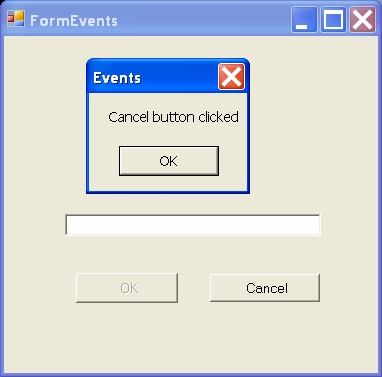Mouse event on a control

/*
C# Programming Tips & Techniques
by Charles Wright, Kris Jamsa
Publisher: Osborne/McGraw-Hill (December 28, 2001)
ISBN: 0072193794
*/
using System;
using System.Drawing;
using System.Collections;
using System.ComponentModel;
using System.Windows.Forms;
using System.Data;
using System.Reflection;
namespace Events
{
/// <summary>
/// Summary description for FormEvents.
/// </summary>
public class FormEvents : System.Windows.Forms.Form
{
private System.Windows.Forms.Button btnOK;
private System.Windows.Forms.Button btnCancel;
private System.Windows.Forms.TextBox textBox1;
/// <summary>
/// Required designer variable.
/// </summary>
private System.ComponentModel.Container components = null;
public FormEvents()
{
//
// Required for Windows Form Designer support
//
InitializeComponent();
//
// TODO: Add any constructor code after InitializeComponent call
//
// Add the following line to the constructor.
Application.Idle += new System.EventHandler(OnIdle);
}
private void OnIdle (object sender, EventArgs e)
{
btnOK.Enabled = textBox1.Text.Length > 0;
}
/// <summary>
/// Clean up any resources being used.
/// </summary>
protected override void Dispose( bool disposing )
{
if( disposing )
{
if (components != null)
{
components.Dispose();
}
}
base.Dispose( disposing );
}
#region Windows Form Designer generated code
/// <summary>
/// Required method for Designer support - do not modify
/// the contents of this method with the code editor.
/// </summary>
private void InitializeComponent()
{
this.btnOK = new System.Windows.Forms.Button();
this.btnCancel = new System.Windows.Forms.Button();
this.textBox1 = new System.Windows.Forms.TextBox();
this.SuspendLayout();
//
// btnOK
//
this.btnOK.BackColor = System.Drawing.SystemColors.Control;
this.btnOK.Location = new System.Drawing.Point(56, 192);
this.btnOK.Name = "btnOK";
this.btnOK.Size = new System.Drawing.Size(80, 24);
this.btnOK.TabIndex = 0;
this.btnOK.Text = "OK";
this.btnOK.Click += new System.EventHandler(this.btnOK_OnClick);
this.btnOK.MouseEnter += new System.EventHandler(this.OnMouseEnter);
this.btnOK.MouseLeave += new System.EventHandler(this.OnMouseLeave);
//
// btnCancel
//
this.btnCancel.BackColor = System.Drawing.SystemColors.Control;
this.btnCancel.Location = new System.Drawing.Point(160, 192);
this.btnCancel.Name = "btnCancel";
this.btnCancel.Size = new System.Drawing.Size(88, 24);
this.btnCancel.TabIndex = 1;
this.btnCancel.Text = "Cancel";
this.btnCancel.Click += new System.EventHandler(this.btnCancel_OnClick);
this.btnCancel.MouseEnter += new System.EventHandler(this.OnMouseEnter);
this.btnCancel.MouseLeave += new System.EventHandler(this.OnMouseLeave);
//
// textBox1
//
this.textBox1.Location = new System.Drawing.Point(48, 144);
this.textBox1.Name = "textBox1";
this.textBox1.Size = new System.Drawing.Size(200, 20);
this.textBox1.TabIndex = 2;
this.textBox1.Text = "";
//
// FormEvents
//
this.AutoScaleBaseSize = new System.Drawing.Size(5, 13);
this.ClientSize = new System.Drawing.Size(292, 273);
this.Controls.AddRange(new System.Windows.Forms.Control[] {
this.textBox1,
this.btnCancel,
this.btnOK});
this.Name = "FormEvents";
this.Text = "FormEvents";
this.ResumeLayout(false);
}
#endregion
/// <summary>
/// The main entry point for the application.
/// </summary>
[STAThread]
static void Main()
{
Application.Run(new FormEvents());
}
private void btnOK_OnClick(object sender, System.EventArgs e)
{
MessageBox.Show ("OK button clicked", "Events");
}
private void btnCancel_OnClick(object sender, System.EventArgs e)
{
MessageBox.Show ("Cancel button clicked", "Events");
}
private void OnMouseEnter(object sender, System.EventArgs e)
{
// Test whether the sender is a button
if (sender is Button)
{
// Change the OK button style to Flat, but the
// change the background color of the Cancel button
if (sender == btnOK)
((Button) sender).FlatStyle = FlatStyle.Flat;
else if (sender == btnCancel)
((Button) sender).BackColor = SystemColors.ControlLightLight;
return;
}
// Add code here to handle MouseEnter event for other controls
}
private void OnMouseLeave(object sender, System.EventArgs e)
{
// Test whether the sender is a button
if (sender is Button)
{
// Change the OK button style to Flat, but the
// change the background color of the Cancel button
if (sender == btnOK)
((Button) sender).FlatStyle = FlatStyle.Standard;
else if (sender == btnCancel)
((Button) sender).BackColor = SystemColors.Control;
return;
}
// Add code here to handle MouseLeave event for other controls
}
}
}
Related examples in the same category